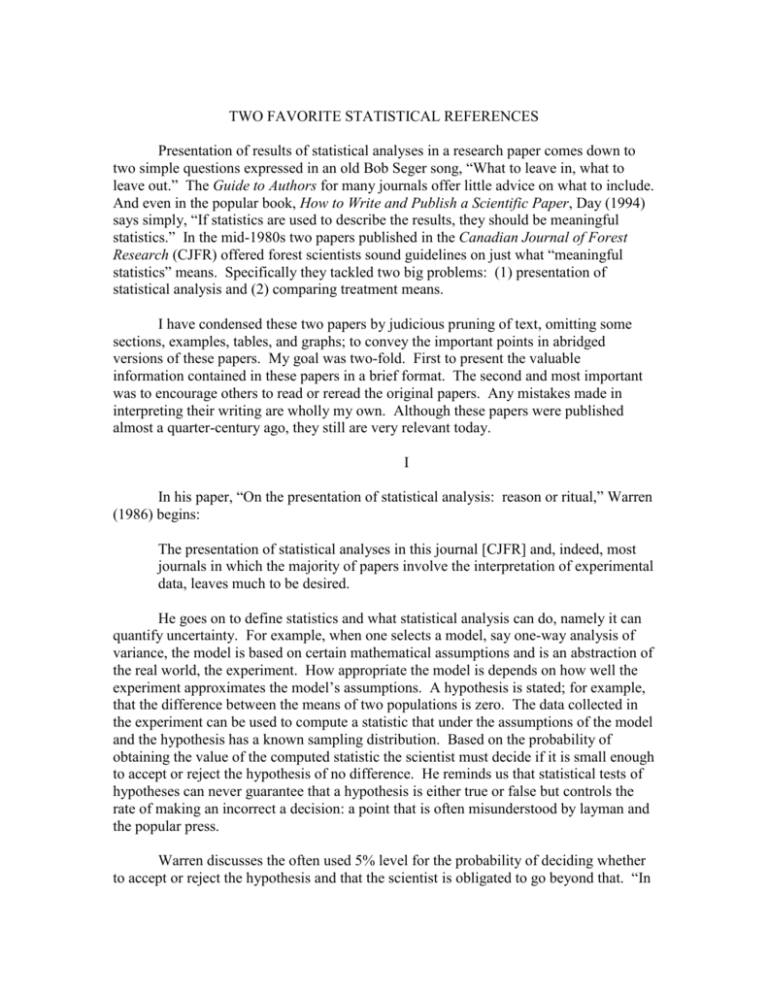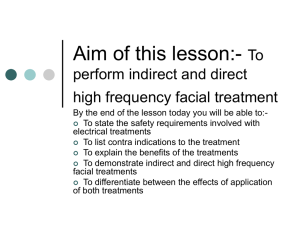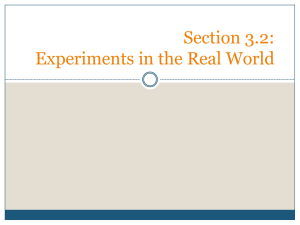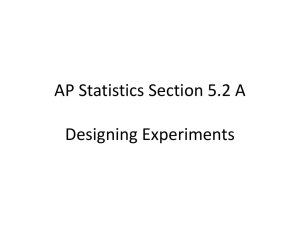TWO FAVORITE STATISTICAL REFERENCES
advertisement

TWO FAVORITE STATISTICAL REFERENCES Presentation of results of statistical analyses in a research paper comes down to two simple questions expressed in an old Bob Seger song, “What to leave in, what to leave out.” The Guide to Authors for many journals offer little advice on what to include. And even in the popular book, How to Write and Publish a Scientific Paper, Day (1994) says simply, “If statistics are used to describe the results, they should be meaningful statistics.” In the mid-1980s two papers published in the Canadian Journal of Forest Research (CJFR) offered forest scientists sound guidelines on just what “meaningful statistics” means. Specifically they tackled two big problems: (1) presentation of statistical analysis and (2) comparing treatment means. I have condensed these two papers by judicious pruning of text, omitting some sections, examples, tables, and graphs; to convey the important points in abridged versions of these papers. My goal was two-fold. First to present the valuable information contained in these papers in a brief format. The second and most important was to encourage others to read or reread the original papers. Any mistakes made in interpreting their writing are wholly my own. Although these papers were published almost a quarter-century ago, they still are very relevant today. I In his paper, “On the presentation of statistical analysis: reason or ritual,” Warren (1986) begins: The presentation of statistical analyses in this journal [CJFR] and, indeed, most journals in which the majority of papers involve the interpretation of experimental data, leaves much to be desired. He goes on to define statistics and what statistical analysis can do, namely it can quantify uncertainty. For example, when one selects a model, say one-way analysis of variance, the model is based on certain mathematical assumptions and is an abstraction of the real world, the experiment. How appropriate the model is depends on how well the experiment approximates the model’s assumptions. A hypothesis is stated; for example, that the difference between the means of two populations is zero. The data collected in the experiment can be used to compute a statistic that under the assumptions of the model and the hypothesis has a known sampling distribution. Based on the probability of obtaining the value of the computed statistic the scientist must decide if it is small enough to accept or reject the hypothesis of no difference. He reminds us that statistical tests of hypotheses can never guarantee that a hypothesis is either true or false but controls the rate of making an incorrect a decision: a point that is often misunderstood by layman and the popular press. Warren discusses the often used 5% level for the probability of deciding whether to accept or reject the hypothesis and that the scientist is obligated to go beyond that. “In short, statistical analyses provide objective criteria to aid in the decision-making process: they do not, in themselves provide the decision.” A point he emphasizes several times, for example, “…I must explain further my contention that statistical analyses provide objective criteria to aid in the decision-making process and that decisions are made subjectively, after due consideration of the analyses, on the basis of the researcher’s prior knowledge, experience, and beliefs.” The bulk of the paper is devoted to a discussion of four deficiencies of presentation of statistical analyses identified by Warren: 1) Failure to specify the assumptions (model), 2) failure to provide sufficient quantitative information, 3) failure to match the statistical analysis to the experimental situation, and 4) apparent violation of model assumptions to an extent that would invalidate the results. He chose recent (at the time) issues of CJFR and reviewed 17 published papers that serve as examples of the four deficiencies, some papers having more than one deficiency. Warren notes that he could find many similar examples to critique in other issues of this and similar journals and more or less apologizes to the authors for having the “luck” as he put it, to have published in the issues he selected. Failure to specify the assumptions (model): Many papers reference a general technique such as an analysis of variance (ANVOA) or regression and cite a book or software manual as if the reader could go to these citations to discover just what was done. Reference to a general technique does not give the reader enough information to determine the model’s assumptions or to know if the analysis satisfied the assumptions, and therefore, validate the test statistic used. Warren reminds us that the assumptions don’t have to be presented as mathematical equations but that writing them out in plain English will serve. The latter implies to the reader that the authors understand the model they used and are not simply copying equations out of a textbook. Failure to provide sufficient quantitative information: The reader should be given enough information about the analytic procedures so that they could reconstruct the analysis that was done. For example, when the procedure used is an analysis of variance, rarely is an ANOVA table included or enough information given to recreate one. Often no quantitative information is given at all and a summary table indicates levels of significance of F-tests by stars and NS. At a minimum, the reader should be given the degrees of freedom (df), the mean squares for all components, and the F-ratios. Alternatively, the experimental error could be stated, eliminating the need to include the mean squares. In any case, it is a good idea to include the experimental error. It is preferable to give actual probability values rather than symbols. Failure to match the analysis to the experimental situation: This failure often presents itself in post-ANOVA analyses in multiple-comparison procedures. Warren identifies Duncan’s multiple-range test as an example of a test most often misapplied in the forestry literature. Several examples are given. Since this subject is the main focus of the next paper I will defer further discussion till then. He sums up this section by stating, The uncritical use of multiple-comparison procedures results in a failure to respond to the questions that the experiment was seemingly designed to address. Apparent violations of assumptions to an extent that would invalidate the results presented: Warren finds that the most common fault here is failure to adjust for heterogeneity of variance. Data can be transformed to achieve uniformity of variance within categories to permit a proper application of ANOVA. But, “the same cannot be said of the pair-wise comparison [of means] or contrasts between category means.” In short, most of the papers cited in this section failed to give enough information so that a reader could determine for himself if the analysis was appropriate for the experiment or results interpreted correctly. But sometimes there is just enough information to cast doubt on appropriateness or interpretation. To add to confusion (not on purpose one hopes) some authors use statistical terminology incorrectly. A problem Warren notes and that I have often seen as a reviewer and reader is the confusion of standard deviation with standard error. Warren defines the two as follows: Standard deviation is a measure of variability in the population and apart from sampling error is unaffected by sample size. Standard error is a measure of the precision of an estimate of a parameter and apart from sampling error will decrease as sample size increases…What should be presented depends on whether the objective is to make a statement about the precision of the estimate [standard error] or about the variability in the population [standard deviation]. To that should be added that whatever parameter is used should be clearly labeled. In his Discussion, Warren identifies what he thinks is at the root of the problem. Because of the importance of statistical methods in evaluating experimental data a course in statistics became mandatory for students. This is usually an elementary, hands-on, how-to course without teaching the principles that underlie the techniques. As part of these courses, students are trained to use one of the many widely available statistical analysis computer packages. Unfortunately these programs offer little guidance in selection of the appropriate model and options to analyze the specific experimental data at hand. Research journals and journal reviewers (referees) could do more to restore the presentation of statistical analyses to its important role as a tool “to be used with reason and logic and not as a ritual.” II In their paper, “Comparing treatment means correctly and appropriately,” Mize and Schultz (1985) begin: …Statistical analyses are done to assist in the comparison of treatment mean differences. More often than not, however, the analyses done on a particular experiment are inappropriate for that experiment. As a result, the treatment responses may not be clearly identified or may be improperly interpreted. After an ANOVA has been run the researcher wants to compare treatment means and identify differences. Mize and Schultz make it clear that the researcher should be primarily interested in discussing the statistical significance of consequential differences. For example, a difference could be statistically significant but inconsequential. A costly change in a tree nursery practice may not be warranted to obtain a response deemed inconsequential although found to be statistically significant. The paper discusses four methods used to examine relationships between treatments and responses in designed experiments in forestry. Mize and Schultz identify the four methods as: 1) Ranking treatment means, 2) multiple comparison procedures (e.g., Duncan’s multiple-range test), 3) regression techniques used to fit a response model, and 4) the use of contrasts to make planned comparisons among individual means or groups of means… And, they define a few basics to set the stage: “A factor is a kind of treatment, e.g., nitrogen fertilizer, residual basal area per acre…Some experiments…called singlefactor...consider the effect of only one factor…[others] called multifactor…consider the effect of two or more factors at a time. Quantitative treatments are ones that represent different levels or amounts of one factor, e.g., pounds of nitrogen fertilizer per acre…Qualitative factors contain treatments that are different in kind, e.g., species of mycorrhizae…” The authors describe each of the four techniques and where they should be used. They use as examples research in which they have been involved. It would be difficult to if not impossible to briefly summarize because they refer to tables and graphs to a considerable extent. To reproduce the tables and graphs would be to reproduce their paper. Instead, I will emphasize key points under each method, which is a poor substitute for reading the paper. Ranking of means: In many single-factor experiments with qualitative treatments the objective is simply to identify the treatment or treatments that have the highest or lowest mean or means. An ANOVA need be done only if an estimate of the experimental error is desired. Results can be presented as a table of treatments and means ranked from highest to lowest. As with all experiments, randomization and replication are required. Multiple comparison procedure: A procedure such as Duncan’s multiple-range test should be used for single-factor experiments with qualitative treatments where the objective of the experiment is to group treatments that have similar responses or identify treatments that are significantly different from other treatments. There are other multiple-comparison tests. All use a different error rate so treatment means will be separated into slightly different groups. The selection of a test depends on whether or not the researcher wants to be more conservative or more liberal in declaring significant differences. The selection should be made in the context of the experimental situation. Mize and Schultz cite a paper by Chew (1976) that ranked the following multiplecomparison procedures in order of increasing likelihood of declaring significant differences (from most conservative to most liberal): Scheffe’s method, Tukey’s honestly significant difference, Tukey’s multiple-range test, Newman-Keul’s multiplerange test, Duncan’s multiple-range test, Waller and Duncan’s K-ratio rule, and Fisher’s least significant difference. Regression techniques used to fit a response model: Single-factor experiments with quantitative treatments are best fitted by regression analysis. A functional relationship between the response and treatment levels is estimated. Two problems may arise. The researcher might not know of a functional model that describes the relationship between response and treatment levels or the number of treatment levels may be too few to fit a model. In these instances, a polynomial function using powers of the treatment levels should be fitted. Mize and Schultz give an example in which height-growth response in sweet gum to three levels of sludge application is measured in a randomized completeblock experiment with nine blocks. They inappropriately compare the means of the three treatment-levels using Duncan’s multiple-range test, obscuring the relationship between the response and treatment levels. A polynomial model was fit resulting in a significant linear relationship and an appropriate interpretation of the experimental data. They quote Mead and Pike (1975) who said, “The number of situations [using multiple-comparison procedures to analyze a quantitative factor] where a method like Duncan’s…is appropriate is very severely limited.” Use of contrasts to make planned comparisons: Perhaps this is the most complex of the methods for comparing treatment means. Mize and Schultz identify two situations in single-factor experiments where the use of planned contrasts is appropriate to compare treatment means. The first is where qualitative treatments can be broken into groups by similarities. The second is where quantitative treatments have a control. Contrasts among treatments must be established before the experimental data have been examined. There are methods to compare treatments that are suggested by the data (therefore, unplanned) but they are more conservative in declaring significant differences. All of these techniques can be used in multi-factor experiments. Multi-factor experiments generally have an objective of examining the effect of each factor on the response but they also examine the effects of interaction of the factors. For example, an experiment with two factors examines the effect of each factor and the effect of the interaction of the two factors. If the interaction is not significant, the experiment can be thought of as a single-factor experiment, and the main effects (treatment means averaged over all other factors), can be compared by any of the four methods presented. If the interaction is significant, then discussion of main effects is inappropriate. The analysis is somewhat more complicated and should begin with plotting the means of the interacting factors. The nature of the plots, particularly if the plotted lines cross or merely have different slopes but do not cross, determine if the main effects can be presented or not. In experiments with more than two factors, significant three-way or higher interactions are often difficult to explain. Significant interactions between factors require a thorough discussion of the results to fully understand the relationships observed. Mize and Schultz close with some good advice but perhaps the most important is to consult with a statistician during the design, analysis, and interpretation of an experiment. As they note, “…to design an efficient experiment and properly analyze and interpret it requires more statistical background than many researchers have.” In this environment of limited resources, research should be conducted efficiently. Paul E. Sendak Scientist Emeritus USDA, Forest Service, Northern Research Station References Chew, V. 1976. Comparing treatment means: a compendium. Hort-Science, 11: 348357. Day, R.A. 1994. How to write and publish a scientific paper. Oryx Press, Phoenix, AZ. 223 pp. Mead, R., Pike, D. 1975. A review of response surface methodology from a biometric viewpoint. Biometrics, 31: 803-851. Mize, C.W., Schultz, R.C. 1985. Comparing treatment means correctly and appropriately. Can. J. For. Res. 15: 1142-1148. Warren, W.G. 1986. On the presentation of statistical analysis: reason or ritual. Can. J. For. Res. 16: 1185-1191.





